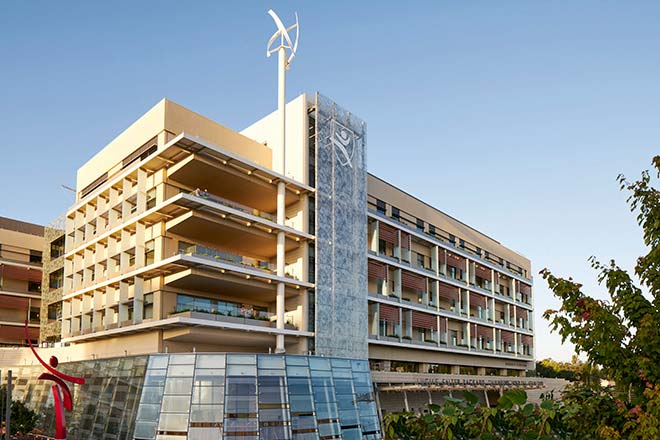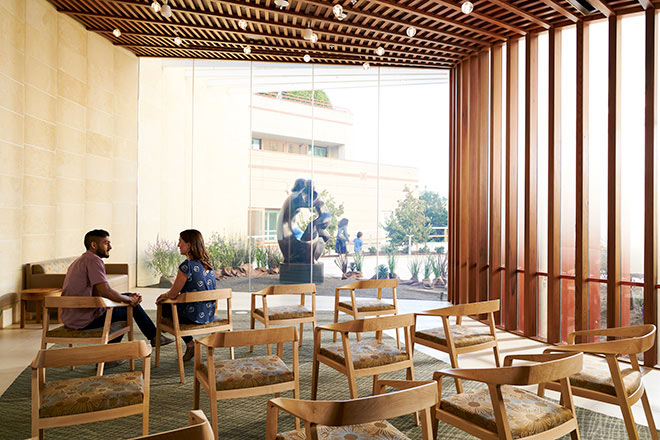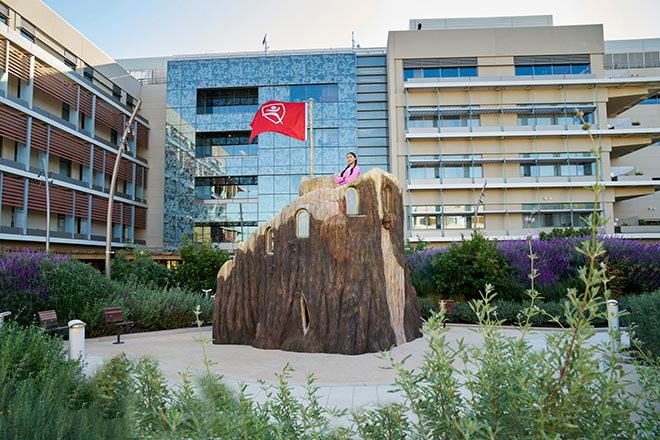Art and Nature Are Part of a Holistic Approach to Healing at Lucile Packard Children’s Hospital Stanford

It was the founding vision of Lucile Salter Packard to marry modern science and technology with a holistic approach to healing the body, mind and spirit. That vision was clear when the hospital first opened in 1991, and it is unmistakably expanded in the design of the new main building at Lucile Packard Children’s Hospital Stanford, which is scheduled to open in December 2017 and more than doubles the size of the existing hospital campus. The new, 521,000-square-foot building combines Stanford Medicine’s advanced medical care and scientific research with a design that seamlessly integrates access to nature as well as abundant depiction of nature though art.
“When my mother founded this hospital, she envisioned a place where children and families could receive truly healing care,” said Susan Packard Orr. “She saw the power that nature had to heal and uplift. I’m proud that we have carried her vision forward, with world-class sustainability and holistic elements throughout the new hospital. Everything we do at this hospital will have an eye to ensuring that generations to come will be healthier.”
Lucile Packard’s vision is reinforced by research that a hospital’s physical environment and the well-being of patients and families are closely related. A hallmark paper in this field was published in Science by environmental psychologist Roger Ulrich in 1984, two years before planning for the original Packard Children’s hospital began. His research was lauded as the first of its kind to use modern medical research to support the healing effects of nature and gardens. Ulrich examined whether views of natural scenery had an impact on patients’ recovery from surgery, and he found they had fewer complications, shorter hospital stays and took fewer medications compared to patients in similar conditions who were exposed only to a view of a brick wall.
Healing by design

The hospital’s expansion, which has been under construction since 2012, adds 3.5 acres of garden and green space, complementing the original building’s numerous terraces and green-lined walkways. The new building’s architects, Perkins + Will in association with Hammel, Green and Abrahamson, Inc., began by considering the experience of patients as they arrive at the hospital. Visitors to the new building will enter a light-filled lobby with soaring two-story ceilings. A floor-to-ceiling sloping glass wall looks out to the Emerald Garden, an imaginative, open garden space that features a sea-themed play area and an amphitheater for activities and events.
Picture windows, natural light and proximity to nature are prevalent as families move around the hospital. A unique feature of the hospital’s architecture and design are the two outdoor terraces located on every patient care unit. One is dedicated to patients’ families and one is for staff, and both overlook the grounds so families and care teams don’t have to go downstairs to step outside. In the patient rooms, each window has a planter box, reinforcing a connection to nature.
Art at every turn
The hospital’s extensive art collection is designed to engage families, feed the curiosity of children and encourage exploration of the building’s setting within Northern California.
“You’re always trying to engage your child in something when you’re in the hospital,” said Diane Flynn, a member of the Family Advisory Council who provided feedback on some of the building’s design elements. “When my son had to fast before his surgeries, we would walk the halls to try to keep his mind off his hunger. We’d stop at the art on the walls and play ‘can you find’ games. Bringing in art and other elements of interactive play like this to the new hospital was crucial.”
The diverse collection features sculpture and painting, as well as interactive experiences to draw children in. It ranges from a 30-foot kinetic sculpture of the hospital’s “leaping Lucy” logo in the entry garden to 2-inch glass figures of hummingbirds, fish and other species outside the hospital’s Sanctuary. Framed art hangs in each patient room, and on the first floor, a richly colored panoramic California ecosystem mural with interactive features teaches children about the state’s diverse wildlife.
Like a child’s imagination, the art is unlimited in form. In the lobby, one of the most unique pieces is the one-of-a-kind Incrediball Machine. The installation is a mechanically engineered course that employs manual devices to move small spheres through an interpreted model of the Stanford Campus, complete with various landmarks. The spheres end their journey at the new Lucile Packard Children’s Hospital Stanford.
Forging form and function
Navigating any large building can be difficult, particularly for families with a sick child. Hospital visitors can get help finding their way through a system designed around Northern California’s eco-regions, including its rocky shore, redwood forest, valley, desert, foothills and mountains. Stanford University ecologists and hospital patients helped select two animal “ambassadors” for each floor that are endemic to the floor’s eco-region. Sculptures of each ambassador are tucked into stone niches along the main entrance and are repeated near the elevators and in colorful signs on each floor.
Each level’s eco-region theme is reinforced with additional art, like the tide-pool mosaics embedded in the lobby’s Rocky Shore terrazzo floor and the 100 aluminum-cast bird sculptures that are individually suspended from the ceiling so that they appear to be flying up the main staircase. From the welcome desk, families can be directed to “follow the birds upstairs.”
On each ascending floor, four signature sculptures between the existing hospital and the new building serve as wayfinding tools and engaging destinations for patients and families. These include a giant mama bear with her cub, a life-size cow made from donated toys, a mother and baby hadrosaurus in pink bunny slippers, and a family of colorful robots.
Spaces for reflection and recreation

The hospital’s first-floor Sanctuary is a space for families to find solace and support through quiet reflection or group ceremonies. Its spiral shell-shape architecture wraps the indoor space around a healing garden, visible through floor-to-ceiling windows. The garden offers a meditative labyrinth and alcoves separated by hedges to provide a sense of privacy. The garden’s focal point, prominently displayed opposite the large picture window, is a great bronze sculpture depicting a parent embracing their child.
The largest of the hospital’s five gardens is the Dunlevie Garden, named for its benefactor, Elizabeth Dunlevie, chair of the public spaces committee and longtime board member. It features animal and nature installations that are representative of California’s eco-regions, including a puma den, a gophers’ burrow and a hollowed-out redwood tree trunk with climbing stairs.
“The garden was designed to inspire imaginative play as our patients and their families explore the various sculptural elements and plants,” Dunlevie said. “While we have provided paths of animal footprints between the elements that they could easily follow, the goal is for each visitor to make up his or her own games, stories and paths.”

One path leads to a sundial built into the ground. It’s surrounded by life-size sculptures of native animals — a fun place for younger children to crawl atop a tortoise or a sea lion and for older children or adults to stand as the gnomon that casts the shadow to tell time.
“We set out to transform our patients’ families experience with this new facility,” said Jill Sullivan, vice president of strategic space planning and general services. “The roles of nature and art in this hospital are intrinsic to that mission and honor the legacy of our founder. We are thrilled to be able to offer these spaces of beauty and healing to our community.”
Media Contact:
Samantha Dorman
(650) 498-0756
sdorman@stanfordchildrens.org
Kate DeTrempe
(650) 721-8527
kdetrempe@stanfordchildrens.org
About Stanford Medicine Children's Health
Stanford Medicine Children’s Health, with Lucile Packard Children’s Hospital Stanford at its center, is the Bay Area’s largest health care system exclusively dedicated to children and expectant mothers. Our network of care includes more than 65 locations across Northern California and more than 85 locations in the U.S. Western region. Along with Stanford Health Care and the Stanford School of Medicine, we are part of Stanford Medicine, an ecosystem harnessing the potential of biomedicine through collaborative research, education, and clinical care to improve health outcomes around the world. We are a nonprofit organization committed to supporting the community through meaningful outreach programs and services and providing necessary medical care to families, regardless of their ability to pay. Discover more at stanfordchildrens.org.
Connect with us:
Download our App: